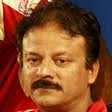India Vs England, First T20, Old Trafford, England
By Vikram Afzulpurkar
The first T20, Eng-Ind of the 2011 tour must be viewed as a celebration of life, good cricket and the global culture.
India getting vanquished by England in the T20 at Old Trafford seemed a ‘regulation’ loss after their middle order collapse when batting first. Let’s then turn to some glorious kaleidoscopic views of global cricket, not that this is entirely unique – the men finishing off for England were Samit Patel and Ravi Bopara. While of course there were eleven other ‘genuinely’ Indian Indians on the field trying to stop them. Patel (oops, Samit of course) drove a ball hard and won the match for England and immediately leapt into the air and celebrated with Bopara.
 |
| United Colours: Patel and Bopara of England |
 A century ago, W.G. Grace would have been confused which side India was, the batting or bowling. However insignificant this is today, it signifies a view we must all take. Colour is no bar. You must play hard for your side and the crowd no less support their home side if they are resident in that country. No matter what your feeling are towards your so called ancestral homeland. Yes, one good development would be to see more Indians settled in the UK actually supporting England in a conspicuous way, although of course the cameramen need to do their part. But the cameras don’t miss much. Unfortunately, many still place their pride in their ancestors’ homeland.
A century ago, W.G. Grace would have been confused which side India was, the batting or bowling. However insignificant this is today, it signifies a view we must all take. Colour is no bar. You must play hard for your side and the crowd no less support their home side if they are resident in that country. No matter what your feeling are towards your so called ancestral homeland. Yes, one good development would be to see more Indians settled in the UK actually supporting England in a conspicuous way, although of course the cameramen need to do their part. But the cameras don’t miss much. Unfortunately, many still place their pride in their ancestors’ homeland. It would have been glorious to see some ‘coloured’ persons in the crowd celebrating the England victory even as Samit and Bopara did it on the field. Well, maybe this change too will come. The game is bigger than anybody. Colour no barrier. Nasser Hussain, it must be said, was categorical almost a decade ago when he captained England that he’d like to see more Indians who are resident British supporting England in the stands.
England on their part played a clinical game, observed India’s mistakes and did not repeat them. Yet they had the strong Eoin Morgan blasting away watchfully. Can we learn from them? While it started well for the Indians, who at a 100+ in good time were just one wicket down, Kohli, Sharma and one or two others failed to capitalize. Why, even the doughty Dravid had slammed three consecutive sixes which showed his resolve. Unfortunately, our team could not capitalize on it.
While conditions in England may be deceptive to Indian viewers who are used to seeing the ball hurry off the bat (on a ‘good’ pitch) and quickly into the stands on their home grounds, one tactic seems a good-to-know– when the ball seems genuinely hittable, they would do well to give it more elevation (only when sure of hitting it beyond the boundary) as the thick English air will carry further.
This would reduce the risk of ‘extra swing’ of the bat which in a commonsense way would have made the batter more vulnerable to the swinging ball. Whereas in sub continental conditions, the batsmen could be given more license to slam the ball hard for two reasons – firstly, a free swinging bat is less likely to be in danger from a swinging ball and secondly, the ball needs to be hit away with that much more power. Anyway, in conclusion, emphasis on too much power in shots might be your undoing as a batsmen, no doubt that power is an essential component in any modern game.
Dropped catches from India may be a thinking matter and fielding coach Trevor Penney, an experienced Zimbabwe and Hampshire player would be putting some new drills in place. Well, after all, maybe the Indians are just a bit rusty in T20! (Did we say a week ago that they’re rusty in Test matches!). That’s the nature of the game – suddenly when something is thrust at you, your other skills come to the fore. But despair not, India may yet prove themselves on this tour. We’re slow starters but not losers.





















